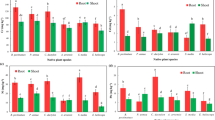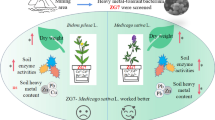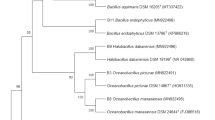Abstract
Phytodesalination of saline soils using selected hyperaccumulating halophytes were evaluated in coastal Bangladesh. Four hyperaccumulating halophytes species—Thankuni (Centella asiatica), Holud nakful (Eclipta alba), Helencha (Enhydra fluctuans) and Lona pata (Sesuvium edmonstonei)—were selected from 35 species grown in different saline regions of Bangladesh. Then, each of the four selected halophytes was grown in 4.36, 4.85, 5.77 and 6.57 deciSiemens/meter (dS m−1) saline soil for four months. All plants were separated into root and shoot after harvesting. Electrical conductivity was significantly decreased in phytodesalinated soil compared to the not-cultivated soils. The maximum phytodesalination capacity (251.22 kg Na+ ha−1) and the highest sodium adsorption ratio (48%) were observed in S. edmonstonei cultivated soil. Translocation factor and bio-concentration factor values indicated that sodium ion (Na+) were readily transported from soil to root to shoot, and all four halophytes were good Na+ accumulator. Distinct anatomical variations were found in microscopic image of root, stem and leaf cells indicating vacuolar and vascular bundle sequestration responsible for Na+ hyperaccumulation. S. edmonstonei and E. fluctuans have high potentiality for the use of halophytodesalination of saline soils.



Similar content being viewed by others
References
American Public Health Association (1985) Standard methods for the examination of water and wastewater, 15th edn. Washington, DC
Australian Bureau of Statistics (2004) Year Book Australia, 2004. Australian Bureau of Statistics, Belconnen, ACT, p 1301.0. Accessed 02 Mar 2013
Banerjee P, Prasad B (2020) Determination of concentration of total sodium and potassium in surface and ground water using a flame photometer. Appl Water Sci 10:113. https://doi.org/10.1007/s13201-020-01188-1
Belkheiri O, Mulas M (2013) The effects of salt stress on growth, water relations and ion accumulation in two halophyte Atriplex species. Environ Exp Bot 86:17–28
Carillo P, Grazia AM, Pontecorvo G, Fuggi A, Woodrow P (2011) Salinity stress and salt tolerance. In: Shanker AK, Venkateswarlu B (eds) Abiotic stress in plants—mechanisms and adaptations. InTech, Rijeka, pp 21–38
Hagemeyer J, Waisel Y (1988) Excretion of ions (Cd2+, Li+, Na+ and Cl−) by Tamarix aphylla. Physiol Plant 73(4):541–546
Hajibagheri MA, Hall JL, Flowers TJ (1984) Stereological analysis of leaf cells of the halophyte Suaeda maritime (L.) dum. J Exp Bot 35(10):1547–1557
Hasanuzzaman M, Nahar K, Alam M, Bhowmik CP, Hossain A, Rahman MM, Prasad VNM, Ozturk M, Fujita M (2014) Potential use of halophytes to remediate saline soils. Bio Med Res Int. https://doi.org/10.1155/2014/589341
Hosen MML, Islam MS, Uddin MN, Haque KA, Islam MS (2016) Effect of sodium chloride on growth and development of sodium accumulating halophytes in saline water. J Environ Sci Nat Resour 9(1):9–15. https://doi.org/10.2136/sssaj1965.03615995002900060025x
Islam MS, Hosen MML, Uddin MN (2019) Phytodesalination of saline water by using Ipomoea aquatica, Alternanthera philoxeroides and Ludwigia adscendens. Int J Envrion Sci Technol 16(2):965–972. https://doi.org/10.1007/s13762-018-1705-z
Jackson ML (1973) Soil Chemical Analysis. Prentice Hall Inc., Englewood Cliffs
Jamil A, Riaz S, Ashraf M, Foolad MR (2011) Gene expression profiling of plants under salt stress. Crit Rev Plant Sci 30(5):435–458
Jlassi A, Zorrig W, Khouni AE, Lakhdar A, Smaoui A, Abdelly C, Rabhi M (2013) Phytodesalination of a moderately-salt-affected soil by Sulla carnosa. Int J Phytoremediation 15:398–404
Jouyban Z (2012) The effects of salt stress on plant growth. Tech J Eng Appl Sci 2:7–10
Karakas S, Cullu MA, Kaya C, Dikilitas M (2016) Halophytic companion plants improve growth and physiological parameters of tomato plants grown under salinity. Pak J Bot 48:21–28
Lastiri-Hernández MA, Álvarez-Bernal D, Moncayo-Estrada R, Cruz-Cárdenas G, Silva García JT (2021) Adoption of phytodesalination as a sustainable agricultural practice for improving the productivity of saline soils. Environ Dev Sustain 23:8798–8814. https://doi.org/10.1007/s10668-020-00995-5
Machado RMA, Serralheiro RP (2017) Soil salinity: effect on vegetable crop growth. Management practices to prevent and mitigate soil salinization. Horticulturae 3:30
Muchate NS, Nikalje GC, Rajurkar NS, Suprasanna P, Nikam TD (2016) Physiological responses of the halophyte Sesuvium portulacastrum to salt stress and their relevance for saline soil bio-reclamation. Flora 224:96–105. https://doi.org/10.1016/j.flora.2016.07.009
Muhammad Z, Hussain F, Rehmanullah R, Majeed A (2015) Effect of halopriming on the induction of NaCl salt tolerance in different wheat genotypes. Pak J Bot 47:1613–1620
Nouri H, Chavoshi BS, Nirola R, Hassan A, Beecham S, Alaghmand S, Mulcahy D (2017) Application of green remediation on soil salinity treatment: a review on halophytoremediation. Process Saf Environ Prot 107:94–107
Olsen SR, Cole CV, Watanabe FS, Dean LA (1954) Estimation of available phosphorus in soils by extraction with sodium bicarbonate. Circular 939:19
Panta S, Flowers TJ, Lane P, Doyle R, Haros G, Shabala S (2014) Halophyte agriculture: success stories. Environ Exp Bot 107:71–83
Qadir M, Oster JD (2004) Crop and irrigation management strategies for salinesodic soils and waters aimed at environmentally sustainable agriculture. Sci Total Environ 323:1–19
Rabhi M, Ferchichi S, Jouini J, Hamrouni MH, Koyro HW, Ranieri A, Abdelly C, Smaoui A (2010) Phytodesalination of a salt-affected soil with the halophyte Sesuvium portulacastrum L. to arrange in advance the requirements for the successful growth of a glycophytic crop. Bioresour Technol 101:6822–6828
Ravindran KC, Venkatesan K, Balakrishnan V, Chellappan KP, Balasubramanian T (2007) Restoration of saline land by halophytes for Indian soils. Soil Biol Biochem 39(10):2661–2664
Shelef O, Gross B, Rachmilevitch S (2012) The use of Bassia indica for salt phytoremediation in constructed wetlands. Water Res 46:3967–3976
SRDI (2010) Soil salinity in Bangladesh. Soil Resource Development Institute (SRDI), MoA, GoB
Vashev B, Gaiser T, Ghawana T, de Vries A, Stahr K (2010) Biosafor project deliverable 9: cropping potentials for saline areas in India. University of Hohenheim, Hohenheim
Watanabe FS, Olsen SR (1965) Test of an ascorbic acid method for determining phosphorus in water and NaHCO3 extracts from soil. Soil Sci Soc Am J 29(6):677–678
Yan K, Xu H, Zhao X, Shan J, Chen X (2016) Saline soil desalination by honeysuckle (Lonicera japonica Thunb.) depends on salt resistance mechanism. Ecol Eng 88:226–231. https://doi.org/10.1016/j.ecoleng.2015.12.040
Yang YN, Sheng Q, Zhang L, Kang HQ, Liu Y (2015) Desalination of saline farmland drainage water through wetland plants. Agric Water Manag 156:19–29. https://doi.org/10.1016/j.agwat.2015.03.001
Acknowledgements
The authors sincerely thanks to International Foundation for Science (IFS), Sweden (Grant No. C/5867-1), and GARE, Ministry of Education, Government of Bangladesh (Grant No. LS2019899) for financial support to conduct this research work.
Author information
Authors and Affiliations
Corresponding author
Ethics declarations
Conflict of interest
The authors declare that they have no conflict of interest.
Additional information
Editorial responsibility: Hari Pant.
Supplementary Information
Below is the link to the electronic supplementary material.
Rights and permissions
About this article
Cite this article
Islam, M.S., Haque, K.A., Jahan, N. et al. Soil salinity mitigation by naturally grown halophytes in seawater affected coastal Bangladesh. Int. J. Environ. Sci. Technol. 19, 11013–11022 (2022). https://doi.org/10.1007/s13762-022-03912-7
Received:
Revised:
Accepted:
Published:
Issue Date:
DOI: https://doi.org/10.1007/s13762-022-03912-7




